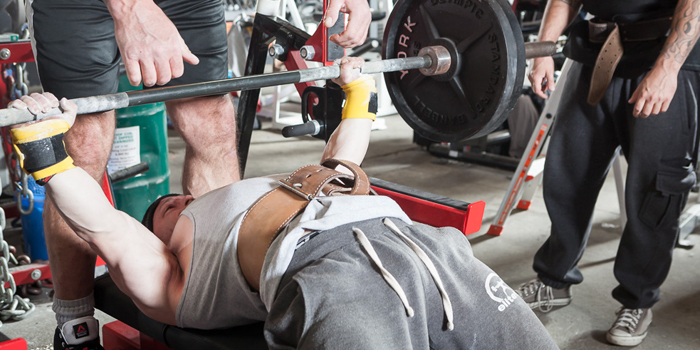
Over on our Q&A section, we often get many programming questions. It’s not uncommon to receive questions regarding how to implement certain aspects of programs in combination with other programs. For most people, the general recommendation is to follow the program as it is intended. The developer of the program had intentions and reasons for why they laid our the programming as such, and changing it no longer makes it that program. However, over the past few years, I’ve played around with figuring out how to take ideas from Jim Wendler’s 5/3/1 and implement them into my own programming. So if you’re a fan of Jim’s work, but also like to run a conjugated program, there could be some really good adjustments to your program just by simply trying some of these out for a training cycle or two.
Let’s get to it.
Max Effort Backdown Sets
Anyone that follows my training log knows that after my main movement on max effort day, I perform a few backdown sets to acquire more volume. This works great for truly building upon the main movement and not just “testing” it. One of the things we know on max effort day is that generally we are working up to a 1-3 rep max for the day. You can also work up to a five-rep max if you wish, if you’re just jumping back into a training cycle. What rep max you use doesn’t really matter, but just know that the more weight you use, the higher your percents will be for the backdown sets. Essentially, when you hit these rep maxes, you are setting your training max for the day. Here are some variations I’ve tried with great success:
Standard 5/3/1
For this option, after you have worked up to your rep max for the day, you are now going to perform the traditional 5/3/1 set up off those numbers. Ideally you will run the same max effort movement for three weeks in a row here. The layout is as follows:
So for an example, let’s say your max effort movement is a low box squat. You work up to 405 for a three-reps max on week one. Your back down sets would be as follows:
- 265x5
- 305x5
- 345x5+
On week two, you would attempt to PR on the low box squat for a three rep max. Ideally you will just make a small PR attempt of, say five pounds. Then on week two, you would run off that number (in this example, 410).
- 285x3
- 330x3
- 370x3+
The great thing about this setup is that you are setting multiple PR’s week in and out. You will also be running off numbers that are applicable for THAT day. You likely won’t PR every single week, so it’s auto-regulating in nature based upon what you can hit. You’re also getting excellent technique work in with the lighter weights and truly improving your ability to get better at a movement that you should suck at.
Top End 5/3/1
This option is a more intensive based approach and works better when you are rotating max effort lifts more frequently, such as every week. Since the lift with be changing so frequently, you can’t run a full-fledged 5/3/1 cycle. You will still work up to your rep max for the day as the same option as above, but here are the prescribed back down sets:
- 95%x1+
- 85%x3+
Just like the first option, you get multiple changes to hit different rep PR’s and continue to build upon the lift you are training for the day. The reason for the two “as many as possible” sets is that with only two sets of backdowns, you can acquire more volume to make up for lack of the third set.
Supplemental Options
With these supplemental options it works best when you know a PR that you’ve hit for the movement (ideally a 1-5 rep max), but if you haven’t, you can go strictly by feel. Since this is a second movement for the day, it works much better with the added volume so that the hypertrophy will help build you max effort movement, so pick good exercises that you know will have direct carryover. Ideally, you will run this for at least a three-week cycle, but I’ve even had success at running them for nine-week cycles. Just make sure that after each three-week cycle, you increase the training max you are using like you normally would (five pounds for upper body movements, and 10 pounds for lower body movements). The great thing here is that you don’t really need to deload due to the lower percentages that are run. I’m not sure I would push this for more than 12 weeks, though, without deloading and then picking a different supplemental movement.
Boring But Big
Here on this option, you will be performing the Boring But Big protocol that Jim utilizes. However, this is only to be used on your supplemental movement. This is a great option for those that need to add mass to fill out a weight class, train with minimal equipment, or train with minimal time.
If you know of a rep PR for the movement, here are the ideal percentages to use:
First Set/Last Set
With the protocol, each week you will take the first set from the traditional 5/3/1 and hit as many reps as possible across three sets. Here would be the ideal percentages to use based upon the rep max you are running your numbers off of:
Standard 5/3/1
This option is designed only for the supplemental movement on dynamic effort days. This is will be run off a 90% training max for beginner to intermediate lifters, and an 85% training max for advanced lifters. The percents are based the same as above on max effort days, but just know the numbers will be not be off a daily training max, hence why the training max MUST be used. This works well for common lifts that you perform like front squats, good mornings, close grip bench press, etc. You can use whatever movement you want here, just make sure the training max you are running off of is rather current.
Dynamic Effort Work-Up Sets
Something I like to do from time to time is implement work-up sets after my dynamic effort work. I took a lot of time and experimentation to get these percentages to work out right with clients and my Purdue Barbell lifters. This option is certainly not for everyone, but the principles are still rooted in 5/3/1. If you opt to perform your work-up sets, please understand that your accommodating resistance should be set at approximately 20-25% of the lift you are training for that day. If you do not do this, I cannot guarantee that the percents will work out in your favor.
Dynamic Squat Cycle
Dynamic Deadlift Cycle
Dynamic Bench Cycle
Breaking It All Down
At the end of the day, how you opt to implement any of the above work is totally up to you. I would recommend that you only use one option at a time to get a gauge of how it works for you and truly see the rewards. After a lot of time experimenting on myself and clients with many of these principles, I’ve found that it not only packs on some serious mass, but builds some incredible strength while keeping numbers manageable and easy to plan for each training session. I by no means take credit for the work Jim did, but I just found a way to implement his methods into a system that I already believe in. There is no doubt that 5/3/1 is an amazing program, and so is the conjugate system. With the perfect blend, you can enjoy both training programs and still be N.O.V.


















We do not based the percentages off a 90% daily max, because the daily max is already taking into account the autoregulation. The main reason Jim Wendler uses the training max, is because one can not really account for the changes in daily readiness and know a true daily max. So for example, one day you might be good for a 400 pound squat, then two weeks later, you might be only good for 380 (say you had a high stress day at work). Having a training max will allow for wiggle room. But, since we are setting the training max for the day, this let's us know in real time what we are "good for". Thus, there is no reason to decrease that max to 90%. Hopefully that helps clear that up.
This is correct.
For the max set, I've taken the time to do the math for you if you can keep your band/chain weight between the 20-25% range I've listed (this is of your max - so if you squat 400 pounds, you would use 80-100lbs of total band or chain weight). So just calculate the percents I have and if your accommodating resistance is that range I've provided, you'll be good!
When implementing this, how would you go about it? Would it be something like Squat Bench ME Deadlift/OHP Then DE Bench and another day DE Squat/Deadlift?
Thanks! Great article
There are a variety of ways I've implemented this. My favorite is train the squat and bench press every week on max effort days per usual. On dynamic effort days though, I would make one week a heavier deadlift day, and the other a dynamic day, so they alternated.
On the overhead press, I would implement this as your supplemental movement after your dynamic effort bench press. You could put it on max effort day, but if you like to overhead press frequently like on a traditional 5/3/1 program, you'd definitely want to do if after your dynamic effort bench press work. You might even find that doing it after your speed bench will help you get better warmed up for the heavier work to come on the overhead press work.
Hopefully that helps!